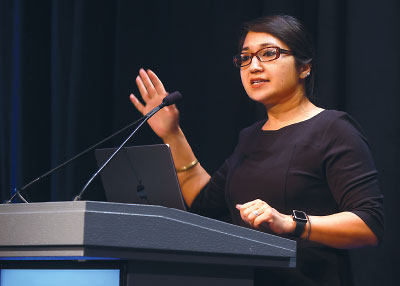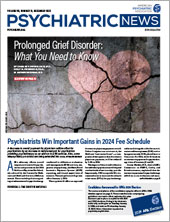Early on during the session on frontline clinician mental health during APA’s Mental Health Services Conference, the session’s chair, Smita Das, M.D., Ph.D., M.P.H., showed the audience some recent headlines. “Burnout threatens primary care workforce and doctors’ mental health,” read one. “Hospitals and clinics are now among America’s most dangerous workplaces,” read another.
“There are the headlines we see every day, but we don’t necessarily need to see them to understand what is going on,” said Das, who is chair of APA’s Council on Addiction. “This is a very real problem that we’re facing, and we feel it. We’ve all had those experiences. We have lost coworkers.”
Das and a panel of experts discussed the urgency to address burnout and improve access to mental health care among frontline health care workers. She was joined by GiShawn Mance, Ph.D., an associate professor of psychology at Howard University; Lena Green, D.S.W., M.S.W., L.C.S.W., an executive director of the Hope Center in Harlem, N.Y., a community-based mental health clinic; and McKenzie Harper, program manager for education with the Dr. Lorna Breen Heroes’ Foundation, which has a mission of reducing burnout among health care professionals and safeguarding their well-being.
Mance said she sees signs of burnout among both her patients and her trainees. Though burnout is an umbrella term, she uses it to refer to what she sees among those left working longer and harder hours after the so-called great resignation, when workers left in large numbers due to the pressures that the COVID-19 pandemic exacerbated. Mance said health care workers are usually silent about their stress because they are supposed to be the healers.
“While we were busy planning and implementing a really intense public health response to the COVID-19 pandemic, we forgot to keep ourselves in mind,” Green said. “Many of us did not feel protected and supported by our institutions during that time, so our institutions became a source of stress for us on top of the stresses of managing ourselves and our families.”
She noted the need for creative, innovative, and inclusive ways to encourage clinicians to engage in mental health care while keeping in mind the trauma they have experienced over the last several years.
Rawle Andrews Jr., Esq., executive director of the APA Foundation (APAF), pointed to APAF’s new resource, Frontline Connect, an initiative of the Center for Workplace Mental Health. Frontline Connect is designed specifically for health system leaders. It provides tools for leaders to reduce stigma, introduce evidence-based approaches to improve access to mental health care, and raise awareness about the importance of seeking help early.
“We want to continue this conversation in and out of these halls, on and offline,” Andrews said. He urged APA members to get in touch with the APAF or recommend Frontline Connect to their health system’s administrators.
It is important that leaders come to a shared understanding with their workforce about the systemic barriers that exist for workers in accessing mental health care, Harper said. Leaders also need to understand what steps they can take to help their staff and how to take those steps. Licensing and credentialing reform is one place to start. Licensing applications often include mental health questions that are stigmatizing and discriminating, causing health workers to fear that dealing with a mental health challenge will put their licenses at risk.
She also pointed to the importance of leaders communicating with worker well-being in mind. “There is a way to communicate that is really imbued with a sense of value for the health care providers in your system,” she said. “As human beings, if you feel like you matter, if you feel like you’re of value as a human being, your interactions are different, your sense of purpose is different, and your job satisfaction is better.”
Especially during the question-and-answer session, the experts spoke about the importance of making changes through policy. “The system is broken,” Mance said. “We need to think about it differently, and not from a perspective of holding up the system we have now, but from a top-down, bottom-up approach.”
“Unless there is buy-in from an institutional perspective, these problems aren’t going to be fixed because this is a leadership and a culture issue,” Das added. ■

